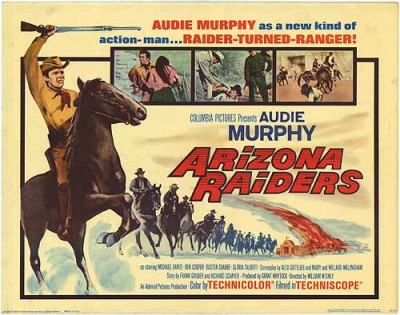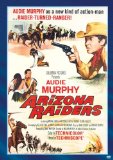| Reviews & Columns |
|
Reviews DVD TV on DVD Blu-ray 4K UHD International DVDs In Theaters Reviews by Studio Video Games Features Collector Series DVDs Easter Egg Database Interviews DVD Talk Radio Feature Articles Columns Anime Talk DVD Savant Horror DVDs The M.O.D. Squad Art House HD Talk Silent DVD
|
DVD Talk Forum |
|
|
| Resources |
|
DVD Price Search Customer Service #'s RCE Info Links |
|
Columns
|
|
|
Arizona Raiders
Robert E. Kent's Admiral Pictures produced Arizona Raiders for Columbia, but otherwise it closely resembles Lyles's Paramount Westerns. It was made for about the same amount of money ($400,000), was likewise shot in Techniscope with Technicolor prints, and stars Audie Murphy, Buster Crabbe, and Gloria Talbott, all on the career downslide but each a welcome presence.
Arizona Raiders is presented in a handsome, 16:9 enhanced widescreen video transfer via Sony's Columbia Classics label (now called their "Choice Collection"). Unlike most such titles, this one includes a trailer, also 16:9 enhanced.
The movie begins bizarrely. In a cramped set decorated with 19th century typesetting equipment, a newspaperman (an uncredited Booth Colman), looks straight into the camera lens to discuss the life of William Clarke Quantrill, who for no clear reason is called "Quantrell" in the movie, and whose infamous, pro-Confederate bushwhackers, among other things, raided Union stronghold Lawrence, Kansas, burning down much of the town and murdering at least 150 men and boys. (Historians waver on the exact number, usually 183-200 or more, with the youngest casualty just 14 years old. Hollywood movies have portrayed Quantrill and his men alternately as heroes and as scoundrels, though more frequently the latter.)
The newspaperman's static lecture - in obvious desperation, Colman nervously fiddles with piles of old newspapers within arm's reach, trying to liven up the scene - goes on for at least six minutes but feels closer to twenty. "Widows wailed, orphans cried, maidens wept," he says, floridly. When at last he finishes there's a fade-out followed by a fade-in to footage of Quantrell (Fred Graham) and his Raiders, accompanied by yet more narration by somebody else, providing much of the same background on Quantrell the audience just heard moments before. Quite clearly Colman's footage was added after the rest of the picture was in the can, but why is anyone's guess. As it was also shot in Techniscope, it presumably wasn't added for television broadcasts. Its addition might have made sense had the film been too short, but even without Colman's scene the picture would have run just under 90 minutes.
In any case, Union soldiers led by Captain Tom Andrews (Buster Crabbe) eventually surround Quantrell and his men, holed up in a barn in Kentucky, in 1865. During their desperate attempt to escape, Quantrell's disloyal lieutenant, Brady (Michael Dante), shoots rival Clint Stewart (Audie Murphy), an embittered raider who joined up after carpetbaggers murdered his parents and burned down his home. He along with compatriot Willie Martin (Ben Cooper) is taken alive, while Quantrell is mortally wounded.
At their trial Captain Andrews speaks on their behalf, but the two are nonetheless sentenced to 20 years hard labor. Brady reunites the surviving members of Quantrell's Raiders in Arizona, intending to rob U.S. Mint shipments there, but yet another rival, Montana Smith (George Keymas), assassinates him. The outlaws make camp at a Yaqui Indian village, murdering the priest who had successfully been converting the tribe to Catholicism, taking the chief and his daughter, Martina (Gloria Talbott), hostage.
Meanwhile, Captain Andrews, now leading the Arizona Rangers, arranges the escape of Clint and Willie on the condition they help him track down the outlaws. Clint agrees but actually plans to escape to Mexico at the earliest opportunity, even after learning that his kid brother, Danny (Ray Stricklyn), is now an Arizona Ranger himself.
Loosely adapted from Columbia's The Texas Rangers - which didn't figure Quantrill in the plot but did include Butch Cassidy, the Sundance Kid, and John Wesley Hardin - Arizona Raiders is quite a good little picture, one of the last of a dying breed of traditional Westerns, and which succeeds on several fronts. Clint's inability to embrace Capt. Andrews's numerous attempts to reform him works dramatically. His bitterness is reasonably motivated, while the paternal interest Andrews takes in Clint and Willie is likewise believable, with Buster Crabbe especially well cast.
Crabbe, of course, had been Flash Gordon and Buck Rogers in four still-popular serials, as well as Tarzan in 1933's Tarzan the Fearless. He later played Billy the Kid in Monogram's super-cheap film series of the 1940s, and during the '50s became famous as TV's Captain Gallant of the Foreign Legion. Crabbe was pushing 60 by the time he appeared in Arizona Raiders but the Olympic Gold Medal-winning swimmer was still lean and handsome and, by now, a better actor than he was in the '30s. As such he's great in this, a father figure to be admired and respected. It's a shame Crabbe had so few parts like this later in life.
The movie was shot on location near Phoenix, on Western streets and in the desert where director William Witney makes good use of these less-familiar locations. The screenplay, by Alex Gottlieb and the husband-and-wife team of Mary and Willard Willingham, has several unexpected, clever plot developments late in the picture to keep things interesting, while its depiction of the Yaqui, Christian converts who revert to ancient ways in the wake of the white man's mass murders, intrigues. (They resort to an ancient practice called "cactus torture." Captured men are poked with cactus needles until their faces look like a porcupine.)
As for Audie Murphy, the highly decorated World War II combat soldier turned actor, he's fine in one of his last roles (he died in a plane crash in 1971). By all accounts personally and financially troubled during this time, Murphy perhaps unconsciously projects some of this unhappiness in his performance, inadvertently adding to its effectiveness.
Video & Audio
Arizona Raiders, filmed in the two-perf Techniscope system, appears quite good on DVD in this 16:9 enhanced transfer. Color is lush and the film elements sourced are in decent shape. The audio, English only with no other choices and no subtitle options, is likewise strong. The disc is region-free.
Extra Features.
The lone extra is a trailer, but it's complete with text and is 16:9 enhanced.
Parting Thoughts
Pretty good for what it is, despite that inexplicable prologue, Arizona Raiders is Recommended.
Stuart Galbraith IV is a Kyoto-based film historian whose work includes film history books, DVD and Blu-ray audio commentaries and special features. Visit Stuart's Cine Blogarama here.
|
| Popular Reviews |
| Sponsored Links |
|
|
| Sponsored Links |
|
|
| Release List | Reviews | Shop | Newsletter | Forum | DVD Giveaways | Blu-Ray | Advertise |
|
Copyright 2024 DVDTalk.com All Rights Reserved. Legal Info, Privacy Policy, Terms of Use,
Manage Preferences,
Your Privacy Choices | |||||||














